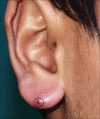Lyme Disease: An Overview
- PMID: 37727539
- PMCID: PMC10506804
- DOI: 10.4103/idoj.idoj_418_22
Lyme Disease: An Overview
Abstract
Lyme disease, a tick-borne multisystem disease, is caused by spirochete Borrelia burgdorferi (sensu lato). It is a common illness in temperate countries, especially the United States, but the incidence is increasing across continents due to increasing reforestation, travel and adventure tourism, increased intrusion in the vector habitat, and changing habitat of the vector. Transmission primarily occurs via bite of an infected tick (Ixodes spp.). The appearance of an erythema migrans rash following a tick bite is diagnostic of early Lyme disease even without laboratory evidence. Borrelia lymphocytoma and acrodermatitis chronica atrophicans along with multisystem involvement occur in late disseminated and chronic stages. A two-step serologic testing protocol using an enzyme-linked immunosorbent assay (ELISA) followed by confirmation of positive and equivocal results by Western immunoblot is recommended for the diagnosis. Transplacental transmission to infant occurs in the first trimester with possible congenital Lyme disease making treatment imperative during antenatal period. The treatment is most effective in the early stages of the disease, whereas rheumatological, neurological, or other late manifestations remain difficult to treat with antibiotics alone. Treatment with oral doxycycline is preferred for its additional activity against other tick-borne illnesses which may occur concurrently in 10%-15% of cases. New-generation cephalosporins and azithromycin are alternative options in patients with doxycycline contraindications. No vaccine is available and one episode of the disease will not confer life-long immunity; thus, preventive measures remain a priority. The concept of post-Lyme disease syndrome versus chronic Lyme disease remains contested for want of robust evidence favoring benefits of prolonged antibiotic therapy.
Keywords: Acrodermatitis chronica atrophicans; Borrelia; Ixodes; Lyme borreliosis; borrelia lymphocytoma; erythema migrans.
Copyright: © 2023 Indian Dermatology Online Journal.
Conflict of interest statement
There are no conflicts of interest.
Figures





References
-
- Feder HM., Jr Lyme disease in children. Infect Dis Clin North Am. 2008;22:315–26. - PubMed
-
- Meyerhoff JO, Steele RW, Zaidman GW, Diamond HS. Lyme disease. [[Last accessed on 2022 Mar 27]]. Available from: https://emedicine.medscape.com/article/330178 .
-
- Sharma RC, Sharma NL. Erythema chronic migrans in Simla, Himachal Pradesh. Indian J Dermatol Venerel Leprol. 1983;49:18–83. - PubMed
-
- Centers for Disease Control and Prevention. Lyme disease: Data and Surveillance. CDC. [[Last accessed on 2022 Mar 27]]. Available from: http://www.cdc.gov/lyme/stats/index.html?s_cid=cs_281 .
Publication types
LinkOut - more resources
Full Text Sources
Miscellaneous

